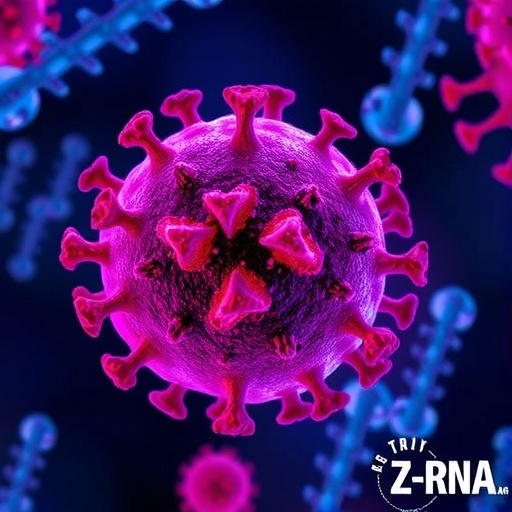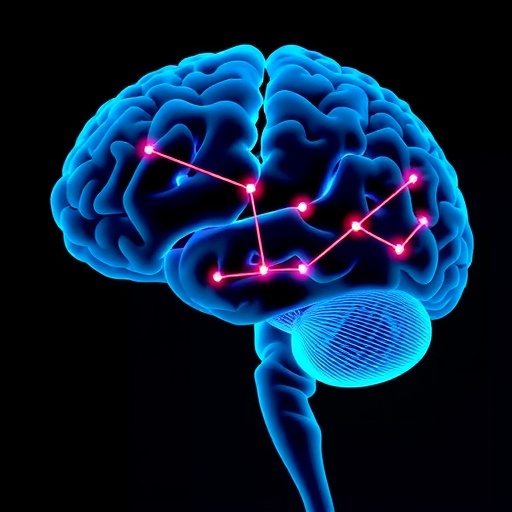In a groundbreaking discovery, researchers have unveiled a novel mechanism by which host cells respond to infections by two prominent human viruses, herpes simplex virus 1 (HSV-1) and Influenza A virus (IAV). For years, it was broadly accepted that these viruses provoke a unique form of cell death initiated by the protein Z-form nucleic acid Binding Protein 1 (ZBP1), primarily through recognition of viral nucleic acids. However, new evidence challenges this long-standing paradigm, revealing that it is actually the host’s own nucleic acids, specifically host-encoded Z-RNAs, that serve as the key activators of ZBP1 during these infections, profoundly shifting our understanding of host-virus interactions.
ZBP1 is a cytosolic sensor known to bind nucleic acids adopting the rare left-handed Z-conformation, particularly Z-RNA, facilitating programmed cell death pathways to counteract infection. Until now, viral RNAs were presumed to be the principal ligands triggering this pathway in HSV-1 and IAV infections. The current study, however, demonstrates that endogenous cellular transcripts are the primary ZBP1 activators under these conditions. This discovery was made possible by meticulous genome-wide mapping which pinpointed the source of these Z-RNAs within intergenic endogenous retroelements (EREs) nestled inside aberrantly elongated 3’ extensions of host mRNAs.
These findings hinge on the viral manipulation of host cell transcription termination. Specifically, both HSV-1 and IAV disrupt the function of Cleavage and Polyadenylation Specificity Factor (CPSF), a critical mediator of pre-mRNA 3’ end processing. The viral proteins ICP27 in HSV-1 and NS1 in IAV were shown to incapacitate CPSF, leading to a phenomenon termed Disruption of Transcription Termination (DoTT). DoTT results in extended nascent transcripts containing aberrantly long 3’ untranslated regions (UTRs) that encompass repetitive retroelement sequences capable of assuming the Z-RNA conformation. These extended transcripts accumulate extensively, providing the substrate for ZBP1 binding and activation.
Intriguingly, when scientists investigated mutant strains of HSV-1 and IAV lacking ICP27 or NS1, the viral proteins responsible for CPSF inhibition, the usual accumulation of host cell Z-RNAs was noticeably absent. This absence correlated directly with a marked reduction in ZBP1 activation and downstream cell death signaling. This causal relationship robustly underscores the critical role of DoTT-mediated transcripts in evoking host antiviral defense, rather than viral RNA species serving as the primary triggers.
Further reinforcing this model, experimental overexpression of either ICP27 or NS1 alone in uninfected cells recapitulated the phenomenon observed during viral infection. These manipulations elicited the accumulation of cellular Z-RNAs and consequent activation of ZBP1, mimicking infection-induced responses. Additionally, pharmacological inhibition of CPSF independently induced the same cascade, highlighting the sufficiency of transcription termination disruption in generating ZBP1 ligands.
The implications of these discoveries extend beyond mere mechanistic insights, shedding light on a sophisticated antiviral strategy employed by host cells. By converting viral-mediated transcriptional dysregulation into a distress signal, cells utilize ZBP1-mediated cell death as a barrier to limit viral spread. This cell death serves both to eliminate compromised cells and to alert neighboring cells to the presence of viral invasion.
Moreover, the localization of these host-derived Z-RNAs within endogenous retroelements underscores a fascinating cross-talk between transposable elements and innate immunity. Historically considered genomic parasites, EREs here emerge as critical platforms in the host antiviral arsenal, their sequences exploited to produce unique nucleic acid structures that activate immune sensors when dysregulated.
These findings bear significance for therapeutic strategies targeting virus-host interactions. Since ICP27 and NS1 function to subvert CPSF and, by extension, host mRNA processing, drugs modulating CPSF activity or stabilizing transcription termination fidelity could push viral infections into regimes favoring robust ZBP1 activation and subsequent viral clearance. Conversely, modulating ZBP1 signaling might offer pathways to curtail tissue damage arising from excessive cell death in viral diseases.
The delineation of DoTT-generated cellular Z-RNAs as bona fide ZBP1 ligands signifies a paradigm shift in understanding intracellular sensing of viral infections. This pivot from viral RNA-focused models to recognizing self-derived nucleic acid triggers reflects the dynamic co-evolution of viruses and their hosts, where cellular defense strategies capitalize on the perturbations viruses introduce into fundamental biological processes.
Beyond HSV-1 and IAV, it remains an open question whether other viral pathogens inducing transcriptional perturbations similarly exploit this mechanism to trigger ZBP1 activation. Future investigations could expand this framework, providing a broader map of host defense tactics mediated by transcriptional anomalies and nucleic acid structural motifs.
In sum, this study offers compelling evidence that disruption of host transcription termination by viral pathogens induces accumulation of cellular Z-RNAs embedded within elongated mRNAs. These cellular Z-RNAs act as potent triggers for ZBP1 activation, leading to programmed cell death as an antiviral strategy. This sophisticated interplay highlights the intricate molecular arms race at the interface of viral offense and host defense, illuminating new avenues for research and treatment in viral pathogenesis.
Subject of Research: Virus-host interactions focusing on the role of host cell Z-RNAs in activating ZBP1 during HSV-1 and Influenza A virus infections.
Article Title: Host cell Z-RNAs activate ZBP1 during virus infections.
Article References:
Yin, C., Fedorov, A., Guo, H. et al. Host cell Z-RNAs activate ZBP1 during virus infections. Nature (2025). https://doi.org/10.1038/s41586-025-09705-5
Image Credits: AI Generated
Tags: cellular transcripts in immune responsecytosolic sensors in immunityendogenous retroelements in infectionsgenome-wide mapping of Z-RNAshost Z-RNAshost-virus interactionsHSV-1 and IAV response mechanismsleft-handed Z-conformation in RNAnovel mechanisms of viral infection responsenucleic acid binding proteinsprogrammed cell death pathwaysZBP1 activation in viral infections





